Noon, Saturday 25 April 2015. In a few horrifying minutes, shortly after we finished writing this tribute to the wondrous plazas of Kathmandu, they were in ruins. Thousands are dead across the country, as well as neighboring parts of India and Tibet. These were people trapped in their homes or buried in avalanches or caught within the tumbling buildings of the plazas – Hindus, Buddhists, Christians, Muslims; Nepali residents and foreign visitors like us. Just two weeks ago we walked where they were walking.
The tragedy, as most natural disasters do, will linger on relentlessly – in injuries, homelessness, sickness, joblessness. This is a poor country that will need years of international help to recover. And it will lose the much needed money brought by outsiders – visitors to these World Heritage Sites, nature lovers at the National Parks and trekkers in the Himalayas. For a long time, few will come here, for only ghosts remain. This piece is now our eulogy for those ghosts.
——
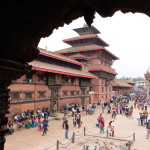
Marco Polo would have felt right at home in Kathmandu. And not because of the ubiquitous pizza places around town serving western and Asian tourists, as well as newly avid locals who also relish clones of KFC, Pizza Hut and Baskin Robbins.
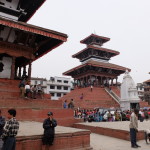
Signor Polo certainly had seen the Himalayas. On his way to China and other explorations, he seems to have visited Tibet. We’re not sure he actually visited Nepal and Kathmandu, but we think he would have gotten this place. For, like Italy, Kathmandu has spacious ancient piazzas that rival any in Italy. In these spaces, myriad temples offer places to pray, grand palaces display the by-gone wealth of powerful princes, and exquisitely crafted religious art in wood and stone is everywhere.
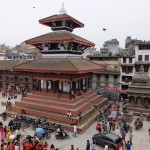
We visited three Durbar Squares in and around Kathmandu, all seats of former kings and their courts at some time. Durbar means palace so the name repeats at places where the royals chose to put their capital cities. In those spaces, we were instantly reminded of Cortona, Montepulciano, Perugia, and even the grand piazza of Siena – without the horses of the Palio, anyway.
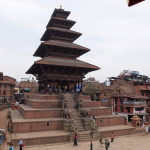
The oldest Durbar Square, and the model for the others, was Bhaktapur, the Nepali capital from the 12th to 15th centuries, about 15 kilometers out of Kathmandu. The successor capitals are Patan, now just a district of Kathmandu, and Kathmandu itself. There, kings of the last few hundred years or so ruled until a crazed prince killed most of the royal family in 2001, when the monarchy fell apart. Years of actual chaos have now yielded to political chaos as the Nepalese attempt to form a constitutional government to their liking.
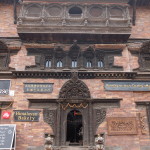
These piazzas date from the 11th and 12th centuries, around Marco Polo’s time, though what we can see now dates back about 500 years, coincident with the Italian Renaissance. Now they are “living museums” whose upper floors are still occupied by locals. As it happens, the ground floors differ quite a bit from the past when they were also residential. Now they are storefronts enticing passers-by, offering foodstuff to residents plus handicrafts and coffees to visitors.
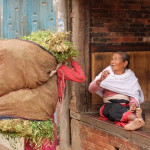
In the past, goods were brought on carts or hauled by hand (as some women still do with chickpeas) to be bartered for other goods in the streets – vegetables for rice, meat for fruits, spices for cloth, and so on. Even today in many villages, that barter system still operates.
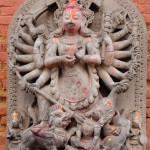
In each of the Durbar piazzas, ancient stone and brick Hindu temples are still open for devotion and prayer. The kings who filled the squares with their palaces and temples were Hindu, as is most of the population today. Finely carved stone statuary and charming intricate woodwork panels adorn their outer walls, as do the support beams and struts of the multiple pagoda-style roofs. The carvings pay homage to the male deities, Vishnu or Shiva, or the female ones like Durga. Durga is an incarnation of the feminine power Shakti and destroyer of evil demons that threaten the gods…and us.
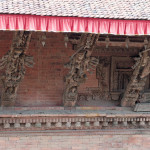
Some of the wood carvings seem primitive in quality, but their frequent whimsy or erotic nature is delightful. By contrast, the splendid geometric carvings around windows and doorways are quite complex.
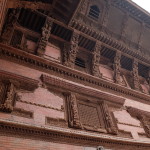
And the woodwork inside the palaces is extraordinarily detailed and sophisticated. No less astonishing are the stone carvings scattered about the squares or hidden away in the palace courtyards for the spiritual refreshment and enjoyment of them by the royal court.
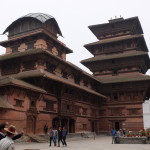
The heirs of the craftsmen who created all this are still carving wood wonders, but in the squares these wonders are for the tourists who want to take a remembrance of the marvels away with them. During the hey-day of the royals, the craftsmen themselves were exported to China to do the same for the dynastic rulers there. The Nepalese locals say that the pagoda style originated here, then became the fashion in China.
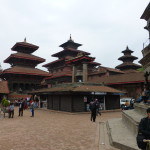
It’s so tempting to examine these details, an endless source of fascination, but – as in Italy – it’s the piazzas overall that make you gasp in awe. Entering one of the gates, the broad open stone terraces send the eye into the distance, then distract it with a temple over here, a shrine over there, the adorned palace wall coming up, a tall column celebrating the king and the kingship.
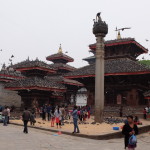
The style of the structures is diverse, but all is harmonious in the grand space, partly because red brick construction dominates.
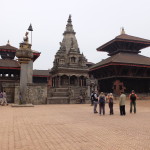
The only discordant element we recall was the oversize British colonial imitation – classical columns and all – at one corner of Kathmandu’s square. In Patan and Kathmandu, the square evolves into other sections, sometimes full of other temples and buildings, sometimes broader and emptier.
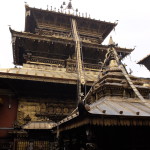
Kathmandu even offers the somewhat misnamed Golden Temple, actually a Nuwari Buddhist monastery adorned with polished brass. It is squeezed into a small side square accessed by a gilded gate. The sound of prayer from the Buddhist nuns, punctuated by bells, horns and drums regularly bounces about, but doesn’t seem to reach the Hindu shrines.
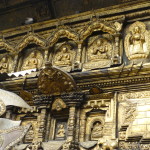
At the square in central Kathmandu, beyond the temples with their divine statuary, you can even visit a living god, known as Kumari. Every few years, a female child is chosen as Kumari, as a kind of incarnation of Shakti. She serves until puberty, then her successor is chosen, and formerly she would head off into obscurity, gaining very little for the honor. Now she is educated during her divinity and offered further education after; she even has to do homework when she is not just being divine. A previous Kumari is currently studying engineering.
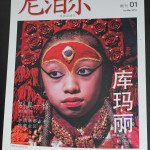
A sighting of Kumari is quiet special to Hindus and a fairly reverent occasion even for tourists. In a small dark-wood trimmed courtyard past a narrow entryway, a glowering monk stared down at us and the gathering crowd. At an appointed time, Kumari suddenly eased into the window next to him. The crowd hushed quickly. Quiet, strictly no photos. All stare up and wait. The monk looked down fiercely for any violation of protocol. She is clearly a girl, but the heavy koli eye makeup and lovely garments make her look otherworldly. She stares abstractedly out for a couple of minutes, then glides away as quickly as she came. You could tell from the odd silence of the fifty plus visitors, they felt something reverent here.
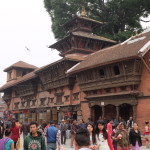
Outside with the crowd, it’s now the people that get your attention. Though access to the squares for foreigners requires paying a fee, the locals have a free pass. The square teems with activity, not a flood like you would find in India, but a pleasant bustle. Residents – women in colorful saris, men more plainly with decorated caps, children in t-shirts proclaiming US cities and NY Yankee caps – do their shopping, sit and talk, or play with simple toys. The foreigners seem to blend in as well, though photo groups in need of images of local color often intrude on the residents. Then you start noticing all those exquisite details crafted on the buildings.
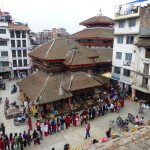
By contrast, the model Durbar Square in Bhaktapur is relatively small in size and numbers of buildings, with a dominant five-layer pagoda style temple in its midst, and a 55 latticed window palace with stunning woodwork inside.
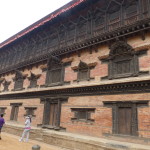
What distinguishes Bhaktapur from its bigger cousins, however, are the well-preserved brick buildings lining narrow streets that connect the Square to smaller, communal spaces, often the location of a water tank/pool. In these, it’s also not so much the detail as the overall effect.
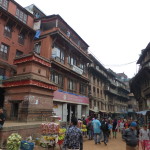
You turn a corner and you gasp again at the color and atmosphere these streets deliver. Still, up in some second and third story windows, men and women lean out to observe the activity. Lower down, a signature Nepali peacock carved into its own window oversees good fortune for the household.
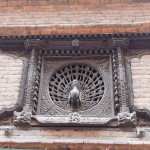
We were fortunate that our visit to Bhakapur and Kathmandu coincided with the Nepali new year festival (mid-April, the year 2072). The local celebrations go on for a week, enlivening the colorful atmosphere.
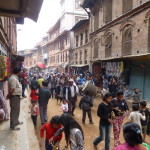
New Year’s Eve itself in the touristy Thamel district of Kathmandu had plenty of public parties on offer at hotels and bars, but most Nepali celebrate with family. As they go to bed early, even these parties tend to break up before midnight. So it’s not like Times Square around here.
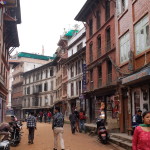
But celebrations during the week reminded us of Italian ceremonies too. In one of those smaller piazzas to which Bhaktapur’s streets lead, a ritualized battle took place. Two teams of eight men, each carrying a small draped shrine with a robed figure within, loudly threatened each other, then charged at the other. As they passed, they tossed a large quantity of red powder at each other, so much that observers closer than us were coated with the stuff.
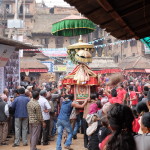
One team clearly lost the battle as they hung their heads a bit, but showed amiability in defeat. But we couldn’t figure out why they had lost. Still, even the loser had a following, as many observers came up to the palette, prayed and made an offering to the statue of the god they carried.
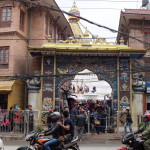
Despite all the splendor of the Durbar Squares, our favorite space in Kathmandu was quite different, the piazza with the massive Buddha stupa, known as Baudhanath, a mound of white in the center of an oval of colorful five-story buildings. It most reminded us of an oval space in Tarragona, Spain, where buildings took the form of the Roman circus once occupying that space.
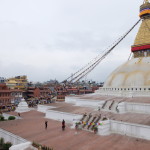
Here in Kathmandu, the piazza and buildings, accessed from non-descript busy commercial streets by four gateways, form the largest mandala in the world. That’s not just an idle description. A mandala represents a method of achieving nirvana, a progress from the material world to a higher plane of consciousness. So, here, you progress from noisy commerce to the more serene space of those encircling colorful buildings, though these too sell to visitors – crafts rather than goods, food and views rather than vegetables.
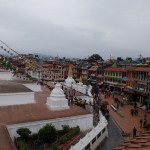
You can then ascend to the large platform surrounding the huge central stupa, keeping your eye on the perhaps unattainable top of the stupa with its symbols of Buddha’s grace, praying or making offerings – or keep your eye on lower things, the delightful buildings and piazza below with its inviting rooftops. Your choice.
They may not run horses around the circle, as the Italians do in Siena, and the mandala might not have charmed Marco Polo, but this piazza can certainly compete for grace and style with any we’ve seen.
(Also, for more pictures from Nepal, Tibet and Bhutan, CLICK HERE to view the slideshow at the end of the Nepal-Tibet-Bhutan itinerary page.)


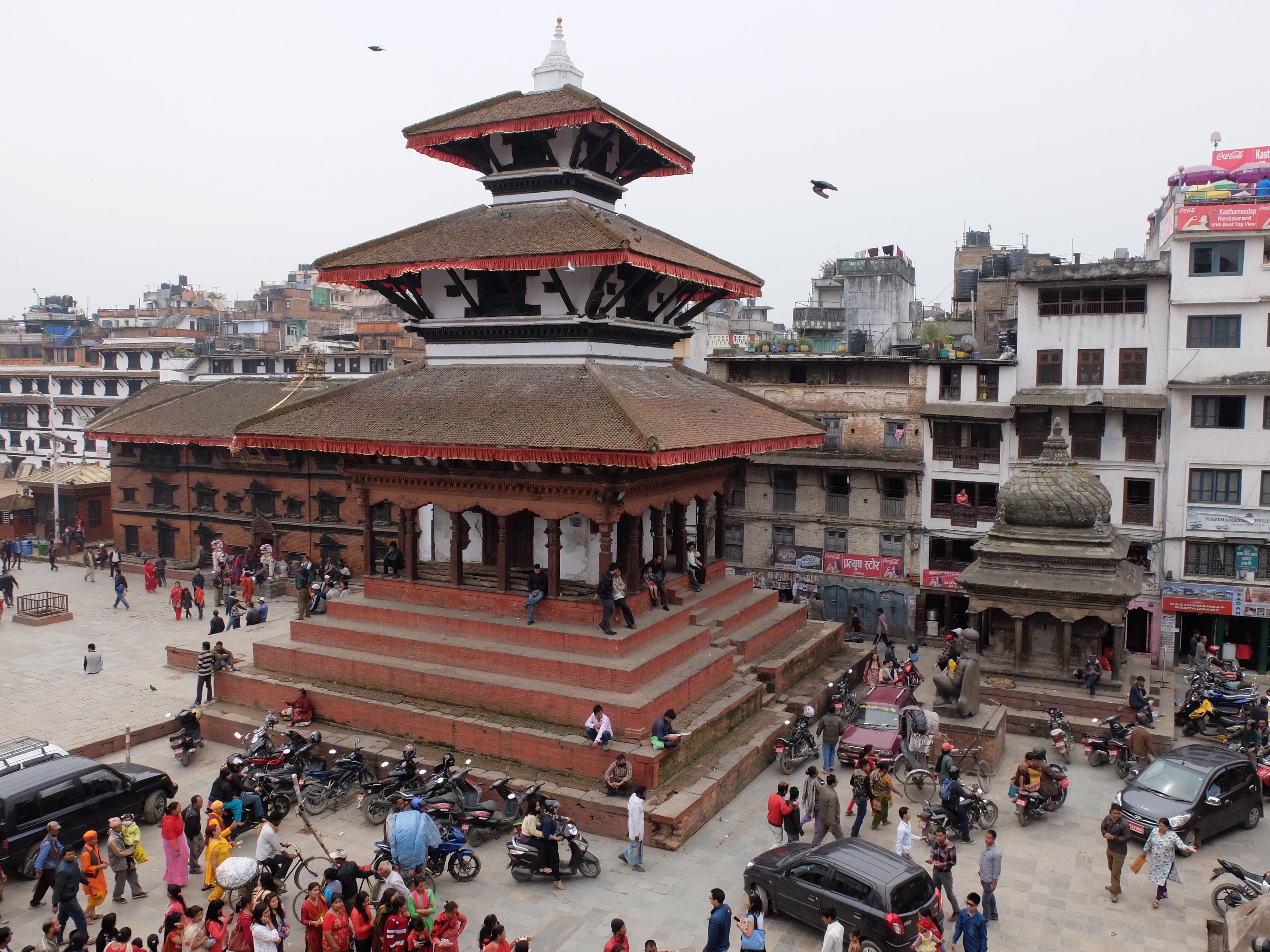
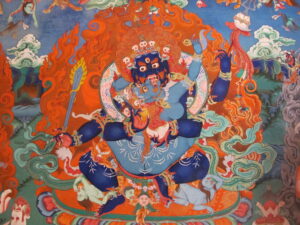
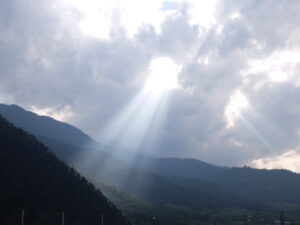
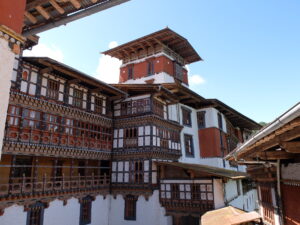
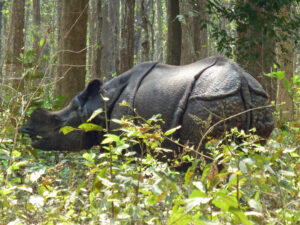
How fortunate you are to have experienced Kathmandu before the earthquake. And how sad you must be that the earthquake visited so much destruction on the beautiful city and its inhabitants.
So true on both counts. We were quite affected by our closeness to the disaster and by the emotions of Nepalis we met.
We are so glad you are safe. Our hearts go out to all the people who are suffering in this terrible event. Please stay safe.
Glad you are ok!
Thank you, all, for your expressions of concern and relief about us. We are fine, but wish that so many of the Nepali people were better off.